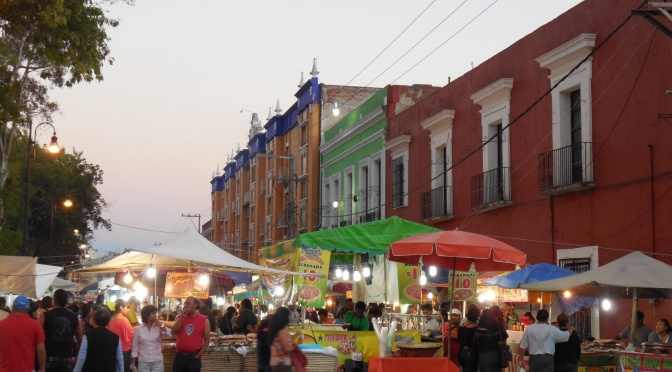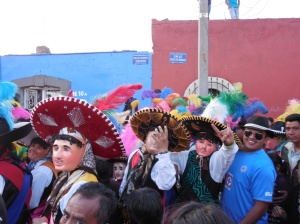Puebla is a beautiful city with an abundance of incredible culture, history, food, religion, arts and crafts. Many attractions deserve their own dedicated posts, which will come in due course as I get to know it better, but for now here are a few photos of my more immediate surroundings:
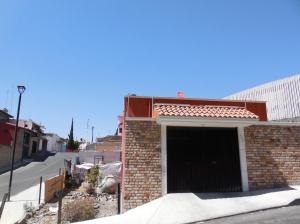
This is my house. Luckily for me, it’s the one on the right, but the comparison with our next door neighbours serves as a constant reminder of the enormous wealth disparity in Mexico. Behind the enormous black gates there is a small forecourt for three cars, and then the house, which is split into two halves. I live in one side with my host parents, and on the other live my host brother and abuelita (grandma). The security might look substantial, but unfortunately it wasn’t enough to prevent our house from being burgled at the weekend. Despite being a nice neighbourhood in one of Mexico’s more affluent cities, it’s not immune from the regrettable reality of crime here.

This is the view just down my road, and it’s a very typical Pueblan vista. Blue sky, check. Multicoloured buildings, check. A scattering of Beetles, check. The Volkswagen Beetle has become an icon of Puebla since VW opened a plant in 1965 on a 2-million-square-metre field in the Pueblan suburbs. The first Beetle rolled off the production line in 1967, and the plant made history in 1981 with its 20 millionth. A further 1.15 million units were made in Puebla between 1997 and 2010. Today the plant builds the coupé and cabriolet versions of the Beetle, the new Golf and the VW Jetta. The sight of so many Beetles, more old than new, give the city streets a distinctive rustic charm.
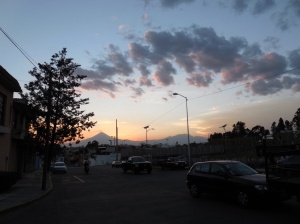
Captured from just behind my house, this is the view of the volcanoes Popocatépetl (meaning Smoking Mountain in Nahuatl) on the left and Iztaccíhuatl (meaning White Woman) on the right. Popo is the second highest peak in Mexico (after Pico de Orizaba), and also Mexico’s most active volcano. Izta is the third highest, but is craterless and dormant. Due to Popo’s temperamental behaviour its summit has been off-limits for the last decade, so I am going to climb Izta in a couple of weeks instead. I love a big volcano!

What do you get when you mix a Catholic calendar crammed with Saints’ Days and celebrations and the Mexican taste for all things bright and beautiful? A church façade adorned with giant, colourful foam décor and a bustling market brimming with rides and street food, of course! Almost every very week there’s a feria (fair) somewhere in the city, and last week the man of honour was none other than San José (Saint Joseph), Spouse of the Blessed Virgin Mary and step-father of Jesus Christ – quite a biggie!
Reading up on Saint Joseph’s Day (which falls on or close to March the 19th), I learned that in Catholic tradition it’s a day of abstinence with the custom of meatless dishes. With an estimated 1.2 billion Roman Catholics in the world I’m sure this may well be the case for any number of them, but in Mexico abstinence isn’t a word that I’ve heard crop up too often: where the theme ‘more is more’ seems apparent in their approach to pretty much everything, why would a religious festival be any different?! Enter embellishment in excess:
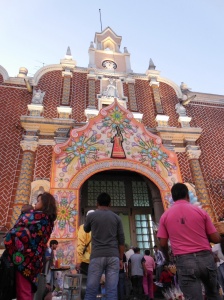
This huge decoration is typical of Mexico’s vibrant colours and patterns; it really embodies the lively, joyful spirit of festivities here.
Regardless of the ‘meatless’ custom (wherever that may or may not be), chalupas are the dish of choice for most street party attendees.
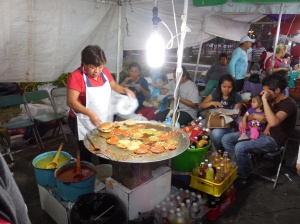
Chalupas are a Pueblan speciality, and when the Poblanos want to eat on the street, it’s most likely to be these greasy little treats they’re looking for. Made from little discs of masa dough, they are fried and topped with either red or green salsa, shredded chicken or pork, and onion. You ask for however many you want and they’re piled high in a big sloppy mess – and served with no cutlery, which just adds to the fun. A delicious dinner for about 50p, you can’t really grumble at that.
So that’s a little insight into my life here in the heart of Mexico. With plenty to see, to do and to taste there’s never a dull moment: it’s a crazy place and they pride themselves on exactly that. It’s everything I dreamed of, feared, and so much more – and I wouldn’t change it for the world.

